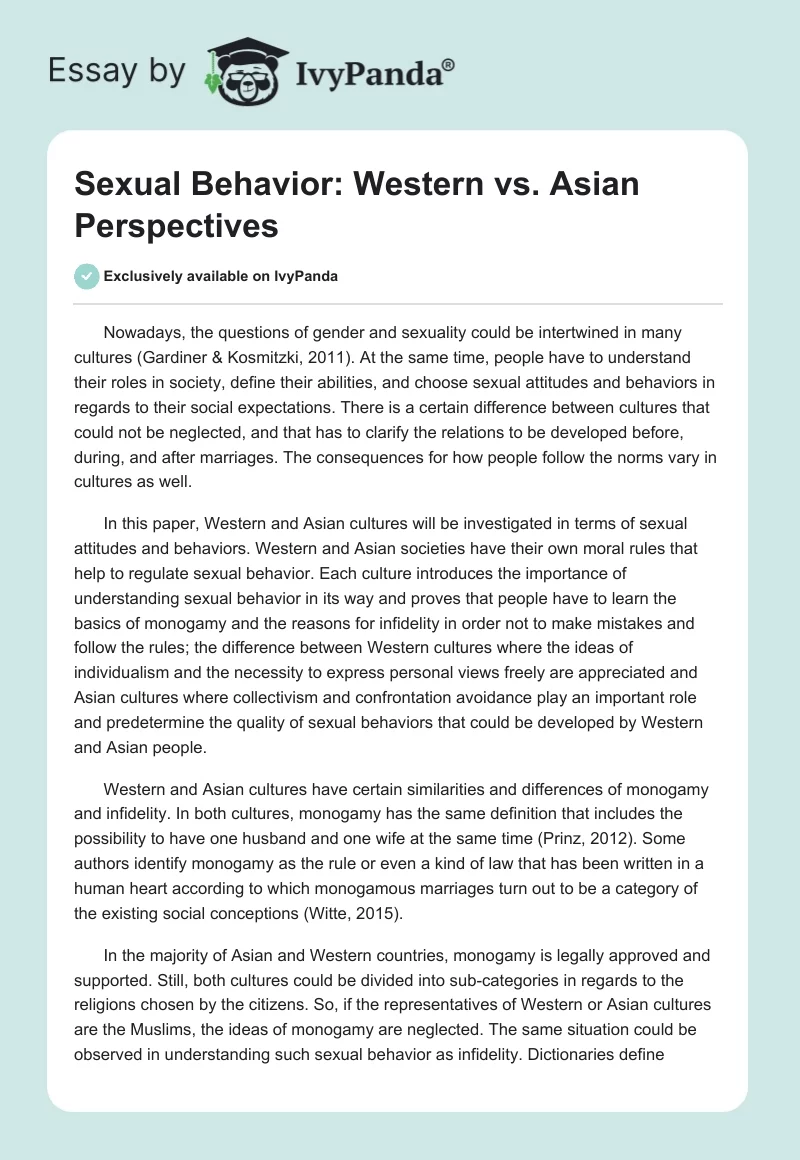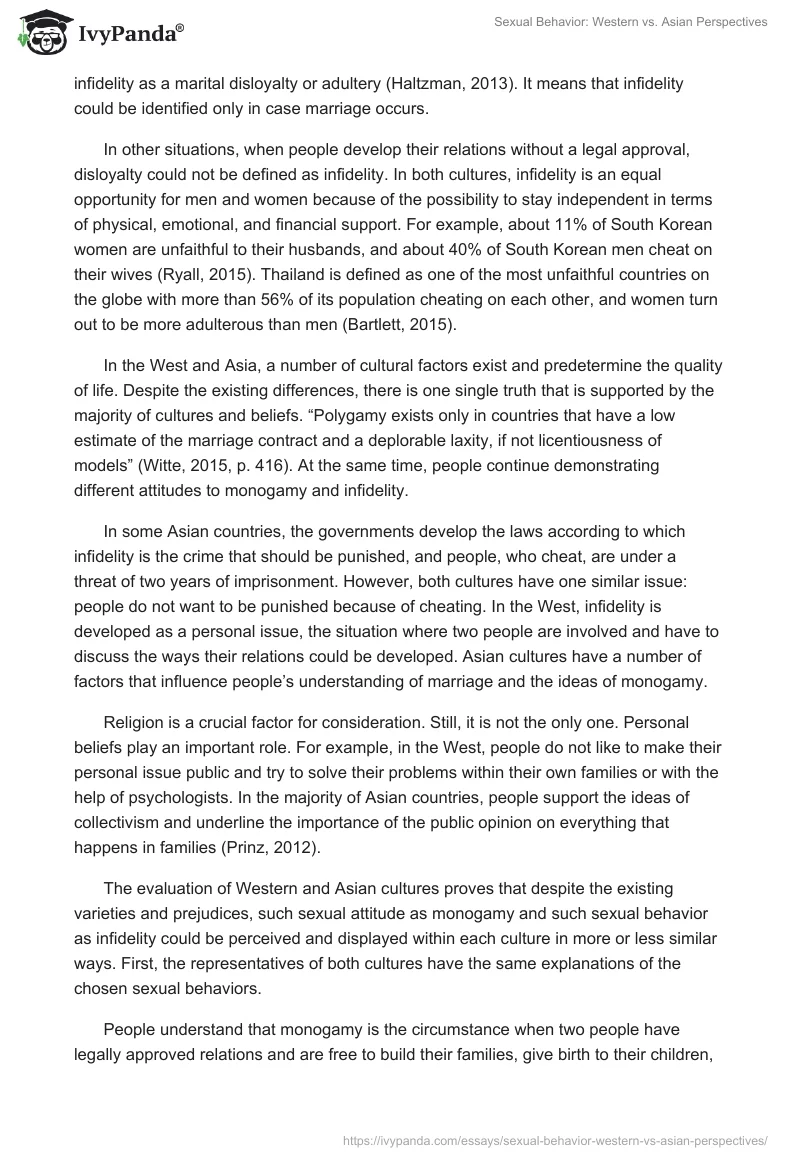Nowadays, the questions of gender and sexuality could be intertwined in many cultures (Gardiner & Kosmitzki, 2011). At the same time, people have to understand their roles in society, define their abilities, and choose sexual attitudes and behaviors in regards to their social expectations. There is a certain difference between cultures that could not be neglected, and that has to clarify the relations to be developed before, during, and after marriages. The consequences for how people follow the norms vary in cultures as well.
In this paper, Western and Asian cultures will be investigated in terms of sexual attitudes and behaviors. Western and Asian societies have their own moral rules that help to regulate sexual behavior. Each culture introduces the importance of understanding sexual behavior in its way and proves that people have to learn the basics of monogamy and the reasons for infidelity in order not to make mistakes and follow the rules; the difference between Western cultures where the ideas of individualism and the necessity to express personal views freely are appreciated and Asian cultures where collectivism and confrontation avoidance play an important role and predetermine the quality of sexual behaviors that could be developed by Western and Asian people.
Western and Asian cultures have certain similarities and differences of monogamy and infidelity. In both cultures, monogamy has the same definition that includes the possibility to have one husband and one wife at the same time (Prinz, 2012). Some authors identify monogamy as the rule or even a kind of law that has been written in a human heart according to which monogamous marriages turn out to be a category of the existing social conceptions (Witte, 2015).
In the majority of Asian and Western countries, monogamy is legally approved and supported. Still, both cultures could be divided into sub-categories in regards to the religions chosen by the citizens. So, if the representatives of Western or Asian cultures are the Muslims, the ideas of monogamy are neglected. The same situation could be observed in understanding such sexual behavior as infidelity. Dictionaries define infidelity as a marital disloyalty or adultery (Haltzman, 2013). It means that infidelity could be identified only in case marriage occurs.
In other situations, when people develop their relations without a legal approval, disloyalty could not be defined as infidelity. In both cultures, infidelity is an equal opportunity for men and women because of the possibility to stay independent in terms of physical, emotional, and financial support. For example, about 11% of South Korean women are unfaithful to their husbands, and about 40% of South Korean men cheat on their wives (Ryall, 2015). Thailand is defined as one of the most unfaithful countries on the globe with more than 56% of its population cheating on each other, and women turn out to be more adulterous than men (Bartlett, 2015).
In the West and Asia, a number of cultural factors exist and predetermine the quality of life. Despite the existing differences, there is one single truth that is supported by the majority of cultures and beliefs. “Polygamy exists only in countries that have a low estimate of the marriage contract and a deplorable laxity, if not licentiousness of models” (Witte, 2015, p. 416). At the same time, people continue demonstrating different attitudes to monogamy and infidelity.
In some Asian countries, the governments develop the laws according to which infidelity is the crime that should be punished, and people, who cheat, are under a threat of two years of imprisonment. However, both cultures have one similar issue: people do not want to be punished because of cheating. In the West, infidelity is developed as a personal issue, the situation where two people are involved and have to discuss the ways their relations could be developed. Asian cultures have a number of factors that influence people’s understanding of marriage and the ideas of monogamy.
Religion is a crucial factor for consideration. Still, it is not the only one. Personal beliefs play an important role. For example, in the West, people do not like to make their personal issue public and try to solve their problems within their own families or with the help of psychologists. In the majority of Asian countries, people support the ideas of collectivism and underline the importance of the public opinion on everything that happens in families (Prinz, 2012).
The evaluation of Western and Asian cultures proves that despite the existing varieties and prejudices, such sexual attitude as monogamy and such sexual behavior as infidelity could be perceived and displayed within each culture in more or less similar ways. First, the representatives of both cultures have the same explanations of the chosen sexual behaviors.
People understand that monogamy is the circumstance when two people have legally approved relations and are free to build their families, give birth to their children, divide their property, etc. Second, both cultures support the idea that monogamy is the call of the heart that cannot be neglected by people. Finally, regarding the importance of monogamous relation, the question of infidelity remains to be urgent as well.
People, who support the idea of monogamous relations, have to understand that infidelity could break monogamy and change their lives. In the West, monogamy and infidelity are the questions of personal satisfaction and choice. People could judge each other and share their opinions. Still, there is no legal support or challenge. Asian people are characterized by collectivism. Therefore, the questions of betrayal and unfaithful relations between spouses could be discussed in public and punished in regards to the existing moral norms and laws.
In general, the discussions of sexual behavior and cultural differences help to understand that despite the varieties people are usually proud of, there is a list of norms and experiences that cannot be neglected or misunderstood. If monogamy is the practice with one person being married to another person at time, it cannot be identified by different cultures in a new way. However, the attitudes to monogamy could be easily changed. Many Western people support the ideas of monogamy and describe perfect relations as the relations that could be developed between two people only.
Asian people introduce another opinion regarding the religions they choose. Monogamy is not acceptable by the majority of Muslims. Still, the Christians approve the rules of monogamy and neglect the appropriateness of infidelity. In fact, Western and Asian perspectives are controversial indeed. However, when the questions about the quality of human relations are raised, people have to admit that devotion, trust, and fidelity are the concepts that are appreciated the most regardless the color of skin, the spoken language, gender, or age.
References
Bartlett, N. (2015). Adultery: Which countries are most unfaithful?Mirror. Web.
Gardiner, H. & Kosmitzki, C. (2011). Lives across cultures: Cross-cultural human development. Boston: Allyn & Bacon.
Haltzman, S. (2013). The secrets of surviving infidelity. Baltimore: The John Hopkins University Press.
Prinz, J.J. (2012). Beyond human nature: How culture and experience shape our lives. New York: Penguin.
Ryall, J. (2015). South Korea sees surge in infidelity after law change ending jail for adultery. The Telegraph. Web.
Witte, J. (2015). The western case for monogamy over polygamy. New York: Cambridge University Press.


